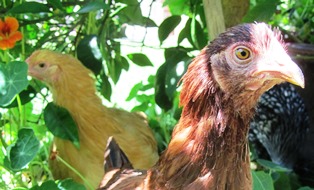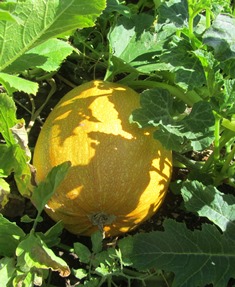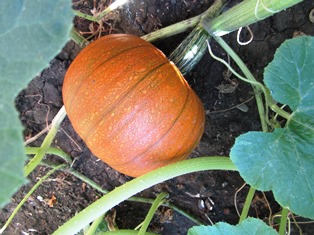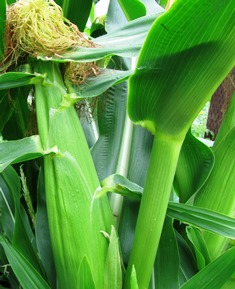Butternut Squash and French Sugar Pumpkins Takes Over the Garden
My organic vegetable garden is a mess of vines. Among the varieties of heirloom tomatoes, Armenian cucumber, summer squash, and eggplant that I planted in late spring, I also tucked in my favorite Butternut squash and French sugar pumpkins. The vines, although producing prolifically, have taken over. I can hardly get in to pick the tomatoes and I can’t see my chickens for the vines.
Next year, I’m going to try Bush Buttercup from Baker Creek Heirloom Seeds. The squash has the same orange flesh and firm rind but grows on bushy plants that say compact and grow between three and four feet high. The fruits weigh three to four pounds.
And maybe, with permission of my neighbor who has a large growing area adjoining our property I might plant Boston Marrow (first documented in 1831). That orange-fleshed squash can weigh up to 15 pounds. A native American tribe distributed the seed to settlers in New York and from there, the seed went to gardens in Massachusetts and spread elsewhere.
Another squash from that Baker Creek Seeds that I’d like to growl is Iran. Collected in Torbat-e-Heydariyeh, Iran in 1940 and preserved at the United States Department of Agriculture since, this is one of the loveliest of the ornamental squash. Orange color mottles its sea-foam green rind.
The pumpkins in my garden are Rouge Vif D’Etampes. I grew these with great success last year and saved the seed of this old French heirloom. A variety of seed companies carry this seed, including Baker Creek Seeds that notes it was one of the “most common pumpkins in the Central Market in Paris in the 1880’s . . . can be picked small and fried.”I like this one especially for pie making.
Squash and pumpkins taste great in Italian, Mexican, French, Middle Eastern, and American recipes. Rich in flavor and nutrients, squash and pumpkins can be made into soups, breads, mixed-vegetable dishes, and pies or can be baked, boiled, steamed, or fried. Even the blossoms are edible. So, it should be apparent why I need more room in my garden. Now to figure out how to keep it orderly.
Summer Garden in Review

Red onions, grown from sets laid onto prepared beds of soil and barely covered with dirt, produced bulbs all summer
As I prepare and amend planting beds to sow some cool season crops, I am also reviewing my summer garden. I will be the first to admit it was less than a stellar year for my vegetables, except for the peppers, eggplants, summer squash, cherry tomatoes and the sweet French pumpkins for pie, Rouge Vif d’Etampes.
We bought seedlings of heirloom tomatoes and also grew some plants from seed (captured and preserved from last year). The paste tomatoes produced abundantly, but I didn’t get many slicing tomatoes and the cantaloupe and Armenian cucumber plants performed dismally for me. Last summer, those two were star performers in my garden.
The German heirloom Riesentraube (the name means “giant bunch of grapes”) will produce sweet, red 1-ounce fruits, if they ever ripen. The plant’s vines have spread like a wild weed all over the garden and are covered in blooms. The plant is a heavy producer but the fruit is still green. To be fair, I planted this one later than the other heirloom tomatoes, so it may yet surprise me.
Of the blue-black tomatoes we planted, the most notable are Blue Beauty and Indigo Apple. I loved the taste and the thin skin of Blue Beauty but Indigo Apple’s small fruit, despite being described as sunburn and crack resistant, suffered from both in my summer garden.
My patch of sweet summer corn produced lots of ears but quickly became infested with corn aphids that I had difficulty controlling. Finally, I ripped out the whole patch.
We had an abundance of raspberries and strawberries this year. Although we picked strawberries every morning from early May throughout the summer, those strawberries kept on blooming and producing. The blackberries produced lots of vines, but few berries. My blueberry bush went into the compost pile–the soil is too clay and alkaline. I’ll try growing one next year in a wine barrel with acid soil, maybe adding some pine needles, sulfur powder, peat moss, and sawdust mulch.
Our White Genoa fig tree is loaded with ripening figs and the Fuji apple, a few feet away, has branches needing support for the low-hanging, heavy apples. We picked and ate all the sweet summer-ripening Bartlett pears. Now, while we await the fall pears ripening, we’ll keep an eye on the blood oranges from which I hope to make marmalade in late winter when the fruit on the citrus trees ripens.
So, in review, this summer’s garden wasn’t the best. But gardeners, myself included, are eternal optimists, ever dreaming of the next plant, the next season. As English writer and gardener Vita Sackville-West astutely observed, “The most noteworthy thing about gardeners is that they are always optimistic . . . always look forward to doing something better than they have ever done before.”
 Facebook
Facebook Goodreads
Goodreads LinkedIn
LinkedIn Meera Lester
Meera Lester Twitter
Twitter









